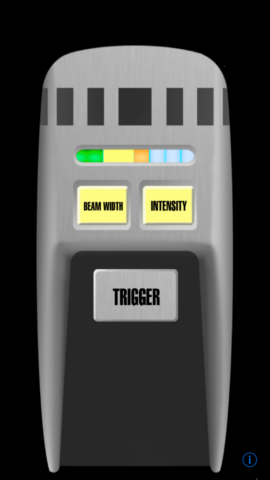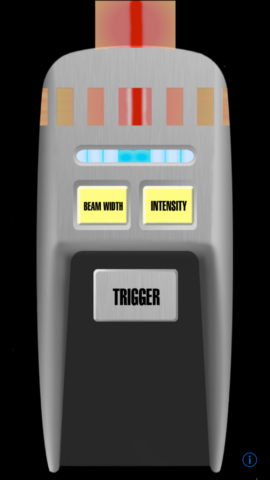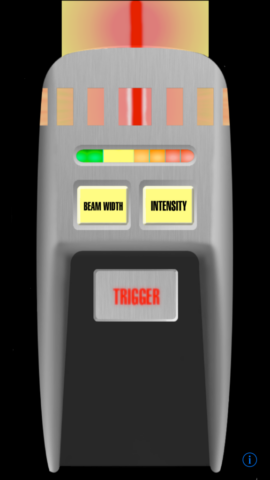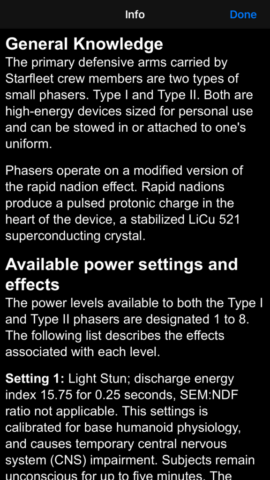Phaser Type I
Since the release of Tricorder TR-580 for the iPhone the single most question we got was, “will there be a Phaser as well?”. The answer is, yes! It took us quite some time to come up with a design which suits the looks and functions of a Star Trek Phaser but we think it came out quite nice.
General Knowledge
The primary defensive arms carried by Starfleet crew members are two types of small phasers. Type I and Type II. Both are high-energy devices sized for personal use and can be stowed in or attached to one’s uniform. Phasers operate on a modified version of the rapid nadion effect. Rapid nadions produce a pulsed protonic charge in the heart of the device, a stabilized LiCu 521 superconducting crystal.
Available power settings and effects
The power levels available to both the Type I and Type II phasers are designated 1 to 8. The following list describes the effects associated with each level.
Setting 1:
Light Stun; discharge energy index 15.75 for 0.25 seconds, SEM:NDF ratio not applicable. This settings is calibrated for base humanoid physiology, and causes temporary central nervous system (CNS) impairment. Subjects remain unconscious for up to five minutes. The damage index for this setting is 0.
Setting 2:
Medium Stun, discharge energy 45.30 for 0.75 seconds, SEM:NDF ratio not applicable. Base-type humanoids are rendered unconscious for up to fifteen minutes, resistant humanoids for up to five minutes. The damage index for this setting is 0.
Setting 3:
Heavy Stun; discharge energy 160.65 for 1.025 seconds, SEM:NDF ratio not applicable. Base-humanoids remain in a sleep state for approximately one hour, resistant bioforms for up to fifteen minutes. Single discharges raise 1cc of liquid water by 100°C. Structural samples experience significant levels of thermal radiation. The damage index for this setting is 1.
Setting 4:
Thermal Effects; discharge energy 515.75 for 1.5 seconds, SEM:NDF ratio not applicable. Base-humanoids experience extensive CNS damage and epidermal EM trauma. Structural materials exhibit visible thermal shock. Discharge of longer than five seconds produce deep heat storage effects within metal alloys. The damage index for this setting is 3.5.
Setting 5:
Thermal Effects; discharge energy 857.5 for 1.5 seconds, SEM:NDF ratio 250:1. Humanoid tissue experiences severe burn effects but, due to water content deep layers will not char. Simple personnel force fields will be penetrated after five seconds. The damage index for this setting is 7.
Setting 6:
Disruption Effects; discharge energy 2,700 for 1.75 seconds, SEM:NDF ratio 90:1. Organic tissue and structural materials exhibit comparable penetration and molecular damage effects as higher energies cause matter to dissociate rapidly. The damage index for this setting is 15.
Setting 7:
Disruption Effects; discharge energy 4,900 for 1.75 seconds, SEM:NDF ratio 1:1. Organic tissue damage causes immediate cessation of life processes, since disruption effects become widespread. The damage index for this setting is 50.
Setting 8:
Disruption Effects; discharge energy 15,000 for 1.75 seconds, SEM:NDF ratio 1:3. Cascading disruption forces cause humanoid organisms to vaporize, as 50% of the affected matter transitions out of the continuum. The damage index for this setting is 120.
For further reading we recommend the Star Trek Next Generation Technical Manual
Disclaimer
This is only a toy, not a real weapon. Don’t try to use it for self defense or hunting. The author of this App can not be held liable for any damage resulting from the use of this App.
Copyright
Star Trek, Starfleet, The United Federation of Planets, and ALL related marks are trademarks of CBS, Paramount Pictures and ViaCom Productions.
All rights reserved.




